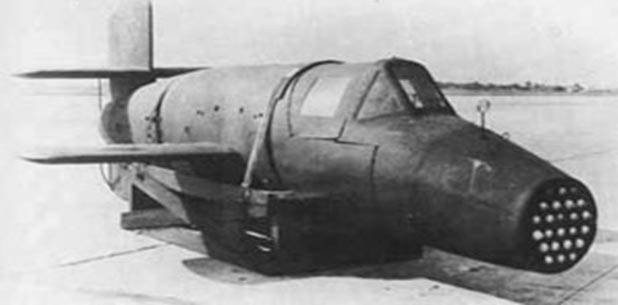The Bachem Ba 349 Natter was probably one of the strangest airplanes ever designed and built during the Second World War. Nicknamed “Viper” by the Allied Forces, this WW2 German aircraft was designed specifically to successfully intercept large formation of Allied bombers which during that time were continuously pounding Germany daily with bombs.
The Ba 349 followed a simple design that even semi-skilled labor could construct one unit in less than one thousand working hours. The design of the wings of this WW2 German aircraft was very simple that they were just plain rectangular slabs made of wood. The wooden-wings did not have any flaps or control devices. The control devices to make the Ba 349 roll, pitch and yaw were installed in the cruciform tail which is made up of four fins and control surfaces. The four control surfaces in the cruciform tail were connected to guide vanes which augmented the control of aerodynamics.
The main engine of the Ba 349 “Viper” was a Walter 109-509A rocket motor that can generate up to 3,740 pounds (lb) of thrust. However, the Ba 349 weighs more than 4,000 pounds when fully-loaded that is why this WW2 German aircraft was installed with four Schmidding 109-533 solid fuel rockets that were bolted two per side to the aircraft’s fuselage. The installation of the additional four rockets to the fuselage made it possible for the Ba 349 to take off vertically and to quickly rise to a suitable attack altitude for intercepting bombers.
The weapons system of the Ba 349 Natter consists of twenty four (24) 2.87-inch Fohn unguided rockets that could be launched in a full volley. The cockpit of this single crew aircraft is heavily armored to protect the pilot long enough to intercept bombers. The principle of the use of the Ba 349 Natter was to be a semi-expendable plane where only the pilot and the four rockets of the fuselage were to be saved after every mission. The idea was to launch this WW2 German aircraft vertically as the Allied bombers get close enough. As the the Ba 349 reaches the attack altitude, the four rockets attached to the fuselage will be jettisoned and the pilot will fire-off a volley of 24 unguided rockets to the closest bomber in the area. The pilot would then set the aircraft’s course to ram another bomber as the pilot ejects out of the plane. (Talk about a cool mission. Of course I’m being ironic.)
SPECIFICATIONS
| Allied Codename: | Viper |
| Type: | one-man crew bomber interceptor |
| Design: | Bachem Aircraft Firm |
| Engine(s): | 1 x Walter 109-509A-2 liquid-fuel rocket that can generate 3,748 lbs of thrust within 70 seconds 4 Schmidding 109-533 solid-fuel rockets that can generate 2,646 pounds of thrust for 10 seconds (will be jettisoned after use) |
| Max Speed: | 800 km/h (497 mph; 432 knots) |
| Max Range: | 25 nautical miles (40 km) |
| Ceiling: | 14,000 meters (45,932 feet; 8.7 miles) |
| Length: | 20.01 feet |
| Wingspan: | 11.81 feet |
| Loaded Weight: | 2,200 kg (4,850 lbs) |
